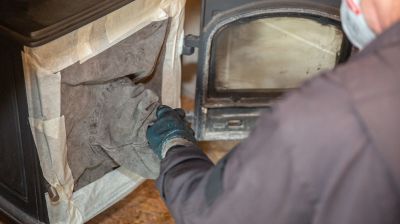Expert Picks For Stove Pipe Repair Solutions You Can Trust
Find the most effective repair products selected by professionals to restore your stove pipe's performance and safety.
 Stove pipe repairs are essential for maintaining the safety and efficiency of heating appliances. When issues arise such as leaks, cracks, or corrosion, selecting the appropriate repair products can help ensure a secure and functional system. Repair solutions range from simple patch kits to more comprehensive sealing options, allowing homeowners and professionals to address various problems effectively. Proper maintenance and timely repairs contribute to safe operation, preventing potential hazards associated with faulty chimney or stove pipe connections.
Stove pipe repairs are essential for maintaining the safety and efficiency of heating appliances. When issues arise such as leaks, cracks, or corrosion, selecting the appropriate repair products can help ensure a secure and functional system. Repair solutions range from simple patch kits to more comprehensive sealing options, allowing homeowners and professionals to address various problems effectively. Proper maintenance and timely repairs contribute to safe operation, preventing potential hazards associated with faulty chimney or stove pipe connections.
Top Overall Option
High-Temperature Stove Pipe Repair Kit
This comprehensive repair kit offers a selection of high-temperature sealants, patches, and tapes designed specifically for stove pipe repairs. Its versatile components are suitable for sealing cracks, leaks, and small holes in metal and stainless steel pipes. Easy to apply and durable under high heat conditions, this kit provides a reliable solution for maintaining the integrity of your stove pipe system over time.
Types of Products For Stove Pipe Repairs
Silicone Sealants
High-temperature silicone sealants are ideal for sealing small cracks and leaks in stove pipes. They adhere well to metal surfaces and withstand heat without degrading.
Repair Tapes
Specialized repair tapes designed for high heat environments can provide quick fixes for leaks and minor damages, offering flexibility and ease of use.
Metal Patches
Metal patches are used to cover larger holes or damaged sections of stove pipes, providing a durable and permanent repair option.
Replacement Sections
Pre-cut or customizable replacement pipe sections help in replacing damaged parts of the stove pipe system for a secure fit.
Clamp Kits
Clamp kits secure patches or replacement sections tightly to the existing pipe, ensuring a seal that can withstand heat and pressure.
Heat-Resistant Epoxy
Epoxy adhesives formulated for high temperatures can bond damaged pipe sections or fill cracks effectively.
Flexible Sealants
Flexible high-temperature sealants accommodate expansion and contraction of stove pipes, maintaining a seal over time.
Gasket Materials
Gasket materials ensure airtight connections between pipe sections, preventing leaks and smoke escape.
Foam Insulation
Insulation foam can be used around pipe joints to improve heat retention and prevent damage from external elements.
Pipe Collars
Pipe collars provide reinforcement around damaged or weak sections of stove pipes, offering additional support.
Popular Choices
Widely used for sealing small leaks and cracks, these sealants are valued for their heat resistance and ease of application.
Popular for quick fixes, these tapes are favored for their flexibility and ability to withstand high temperatures.
Commonly chosen for covering larger damaged areas, these patches are durable and straightforward to install.
Frequently used for replacing compromised pipe segments, ensuring a secure and long-lasting repair.
These kits are popular for securing patches and sections, providing tight seals in high-heat environments.
Favored for bonding and filling cracks, this epoxy offers a strong, heat-resistant repair solution.
Chosen for their ability to accommodate pipe movement, these sealants help maintain airtight connections.
Popular for ensuring tight pipe connections, these kits help prevent leaks and smoke escape.
Used to improve heat retention and protect pipes from external damage, these wraps are commonly sought after.
Understanding the different types of repair products available can assist in choosing the right solution for specific issues. For minor cracks or leaks, sealants and repair tapes are often sufficient to provide a temporary or long-lasting fix. For larger damage or corrosion, patching materials or replacement sections may be necessary to restore integrity. It is important to consider the compatibility of repair products with the type of stove pipe in use, whether it is metal, stainless steel, or other materials.
Proper installation and application of repair products are crucial for effective results. Following manufacturer instructions carefully ensures optimal adhesion and sealing. Regular inspection of stove pipes can help identify early signs of damage, enabling prompt repairs that extend the lifespan of the system. Investing in quality repair products can also minimize the risk of smoke leaks, fire hazards, or carbon monoxide intrusion, promoting a safer environment in your home.
Choosing the right repair products involves assessing the specific needs of your stove pipe system, including the size of the damage, the type of material, and the environmental conditions. Consulting with professionals or researching product specifications can aid in making informed decisions. With the right tools and materials, maintaining your stove pipe becomes a manageable task that supports safe and efficient heating.
Key Buying Considerations
- Compatibility with your stove pipe material, such as metal or stainless steel.
- Temperature rating of the repair product to ensure it withstands operating heat levels.
- Extent of damage to determine whether a patch, sealant, or replacement is appropriate.
- Ease of application, especially for DIY repairs—look for user-friendly products.
- Durability and longevity of the repair solution in your specific environment.
- Flexibility of sealants or tapes to accommodate pipe expansion and contraction.
- Availability of replacement parts or patches that match your pipe dimensions.
- Manufacturer instructions and recommended curing or drying times.
- Safety considerations, including non-toxicity and fire resistance.
- Cost-effectiveness of the repair solution relative to the damage severity.
- Reviews and ratings from other users for insights into real-world performance.
- Compatibility with existing sealing or repair components in your system.
- Resistance to corrosion and environmental factors like moisture or soot.
- Ease of removal or reapplication if future repairs are needed.
- Availability of comprehensive repair kits versus individual components.
